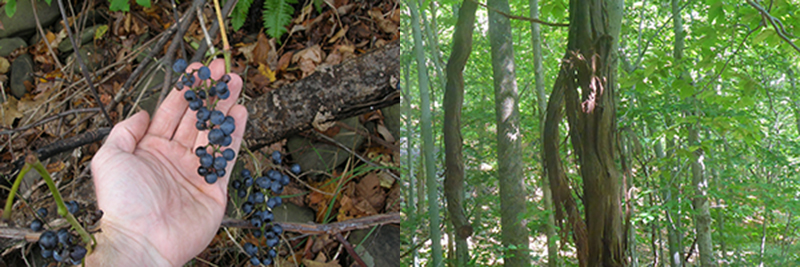As a rule of thumb, I don’t like email. But that rule doesn’t apply when I get forestry questions from woodland owners. I’ve even come to expect and look forward to emails from some landowners. Carrie Sears is one of these people.
As a rule of thumb, I don’t like email. But that rule doesn’t apply when I get forestry questions from woodland owners. I’ve even come to expect and look forward to emails from some landowners. Carrie Sears is one of these people.
Carrie’s most recent question was about native grape vines. You may have seen them on your land: dark brown bark that peels off in long strips, a large leaf, and of course small grapes. They’re excellent for wildlife, as many animals eat the grapes and pollinators will visit the flowers.

So what’s the conundrum? Grape vines sound great! Well, it’s not so simple. Here’s what Carrie wrote me:
“The question on my mind now has to do with native grape vines and trees. So far my thinking has been quite simplistic: native is good and the native plants have co-evolved, etc. I have just been introduced to the idea that grape vines may cause harm to the trees. Can you tell me how to assess when to cut native grape vines? I'm trying to figure out how to compare the vine's wildlife value against potential damage to the tree...”
Great—and tough—question. Grape vines do help wildlife, but they can also damage the trees that they climb, especially if there are a lot of large vines. The vines’ weight can cause tree limbs to break, and in severe cases can even bring the whole tree down (especially during storms).
This is one of those questions where the answer isn’t so much one of science, but of values. There isn’t a “right” decision. Here’s what I sent back to Carrie, shortened a bit for readability here.
“All plants have an impact on other plants. This is true for both native and non-natives. But it is actually your own values that determine whether the effect is good or bad. … So if your goal is to provide food for wildlife, and if you love the aesthetics of grape vines, then perhaps you’ll leave the vines. On the other hand, if you value having trees, and perhaps you only have a small woodlot in your backyard, then you may not want vines that will harm the trees, so they get cut. There is no right answer, only the answer that is right for you.”
Unfortunately, that pure values choice didn’t help Carrie. She wants to help wildlife, but she wants her trees to be healthy too. So she replied back, this time with a more specific question:
“I appreciate the answer, but how do you know when the vine is a threat to the tree?”
This time I’m able to give a little more information. In general, if the vine has spread to a large part of the crown (more than 25%), then the vine is stealing a lot of sunlight the tree would otherwise get. At that size, the vine is also heavy enough that it could damage the tree. The percentage does vary from species to species of tree, but more than 25% of the canopy overtaken by grape vines is a good rule of thumb for when to intervene.
But even then, the choice to intervene is still a values one. So I thought I’d close this blog post by putting the question out to all of you reading this: what about you? Would you keep the grapevines for wildlife, or would you cut them to save a tree? Maybe you’re somewhere in the middle?
I’ve posted a couple photos in the forum showing trees with grapevines growing up them. Share what you would do with them, if anything. Or if you want, post photos of grape vines on your property and how you handled them. And if she’s not busy wrangling invasive plants in Westchester’s Pound Ridge, maybe Carrie will chime in too.





